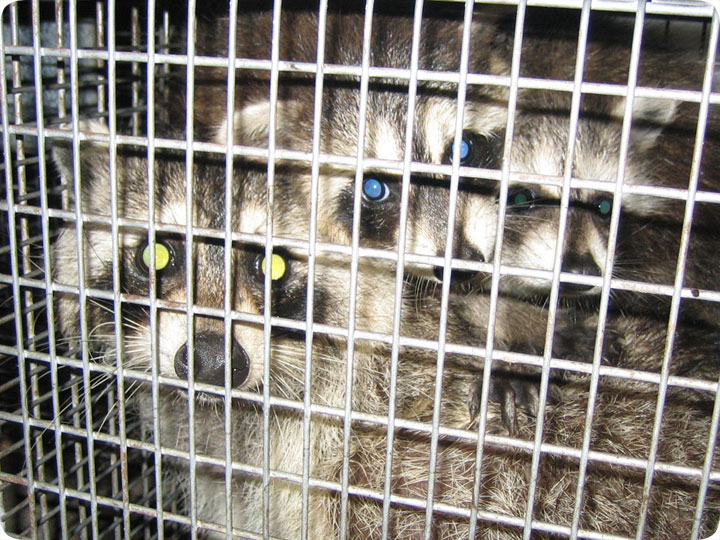-
info@aaanimalcontrol.com
Call us for help in your town
Humane Wildlife Education
Raccoon Eyes - Tapetum Lucidum Effect

04.01.2004 - This is a photo of a mother raccoon and two of her baby raccoons. The babies have grown to a decent size, and are about ten weeks old at this point.
I removed them all from the attic of a home. I actually removed the young raccoons manually, with a snare pole, and then set one each in the back of two traps. The
mother went in the trap to get her babies, and I caught her. I then reunited them all. In this photograph, the young are clinging to mom, and I took the photo of
all three together.
In people during photographs, the light of the flash will often reflect against the retina of the eye and cause red eye in photographs. The
same thing happens to many wild animals, such as raccoons, but since raccoons are nocturnal, like many nocturnal animals, they have a special layer called the tapetum lucidum layer, in their retinas.
This layer reflects light and assists in night vision. That's why many animals' eyes will glow in response to light. This glow reflects a whole spectrum of colors.
In this photo, the three racoons are at different angles, and thus different colors are reflected. Neat!
Do it yourself: Visit my How To Get Rid of Raccoons page for tips and advice.
Get professional help: Visit my Nationwide Pro Directory of wildlife removal experts.
The raccoon (Procyon lotor), is a unique animal native to North America. It's not closely related to any other animals, with distant relatives such as bears and weasels. Coons are easy to recognize, with a black mask and ringed tail. Raccoons tend to weigh between 10-20 pounds
as adults. They are mostly nocturnal, and are omnivores. Racoons average a lifespan of about 5 years in the wild, and have a litter of 3-6 young each spring. They are very strong, excellent climbers, very intelligent, and they are very skilled with their hands. Raccoons have learned to
thrive in urban areas, and live in very high densities in cities, where they eat garbage and pet food. They commonly break into homes and attics, where they cause considerable damage, and they also destroy other property, and thus racoons are considered pest animals by many people. Raccoon
control and removal, especially from inside homes, is best left to a professional.
For more wildlife stories, click my Wildlife Blog
or click my below banner to hire a local trapper.
If you ever step out at night and see two glowing eyes looking right at you, have no fear, they are probably just raccoons. Unless of course, raccoons are not found in your locale, then you should still not fear. You see, raccoons, just like some other nocturnal animals, such as cats or deer, have glowing eyes in the dark and this is because of something they all possess, called the tapetum lucidum.
Tapetum Lucidum
The tapetum lucidum is a layer of tissue in the eye, located just immediately behind the retina of raccoons and some other nocturnal animals. The tapetum lucidum is more reflective than the retina itself, which is why human eyes and the eyes of other animals who do not have it don't glow in the dark.
Purpose of the Tapetum Lucidum
The tapetum lucidum acts as a reflector to bounce back visible light through the raccoon's retina to aid in night vision. When visible light first passes through the retina, the tapetum lucidum, which is right behind the retina, allows the light to reflect and pass again through the retina for the second time. This is what creates the glow we see in their eyes and it allows them to see in much dimmer light than should be possible. The purpose of the tapetum lucidum is to improve vision and it is why they are more superior to humans when it comes to seeing in the dark.
What color are raccoon eyes when they glow in the dark?
It is commonly believed and widely accepted that raccoons glow yellow eyes in the dark. However, a substantial number of people claim to have seen raccoon eyes glow red in the dark. Both claims are not wrong. You see, the glow in raccoons' eyes reflect the whole spectrum of colors. Raccoons have been seen to have yellow, red, blue, and even green eyes glowing in the dark. Although, the most common glow color for raccoon eyes is yellow.
Why different glow colors?
There is a reason for the varying colors of glow in raccoon eyes, and it is due to some factors such as the actual eye color of the raccoon, the light source, and the angle of the visible light. For example, three raccoons kept in the same cage in the dark could give three different colors of glowing eyes, all because of the aforementioned factors. This also means that a single raccoon that once gave off yellow glowing eyes could also give off blue glowing eyes if the angle of light or the source of light is changed. Therefore, there is no singular glow color for raccoon eyes.
Conclusion
The tapetum lucidum effect in the activities of the raccoon cannot be overlooked. Raccoons have been known to sleep during the daylight, preferring to come out of their dens after sunset and scavenge for food. They are highly active at night and often elude capture in the dark. All thanks to their superior night vision.




















